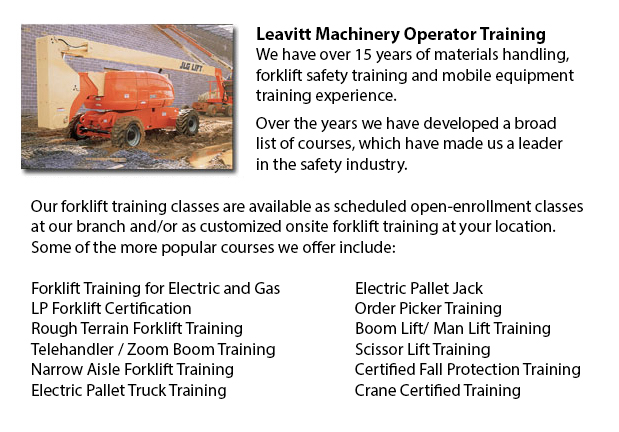
Vernon Boom Lift Certification - Elevated work platforms allow maintenance operations and work to be performed at heights that can not be reached by whatever other method. Boom Lift Certification Training educates workers regarding safely operating boom lifts and scissor lifts.
When work platforms are not operated safely, they have the possibility for serious injury and even death, regardless of their lift style, site conditions or application. Falls, electrocution, tip-overs and crushed body parts can be the terrible result of incorrect operating procedures.
To prevent aerial lift accidents, people should be qualified to train workers in operating the specific type of aerial lift they would be using. Controls should be easily accessible in or beside the platform of boom lifts utilized for carrying workers. Aerial lifts must never be altered without the express permission of the manufacturer or other recognized entity. If you are renting a lift, make certain that it is correctly maintained. Prior to using, safety devices and controls have to be checked to be able to ensure they are functioning correctly.
Operational safety procedures are essential in avoiding incidents. Operators must not drive an aerial lift with an extended lift (although a few are designed to be driven with the lift extended). Set outriggers, if available. Always set brakes. Avoid slopes, but when required make use of wheel chocks on slopes that do not exceed the slope restrictions of the manufacturer. Follow load and weight restrictions of the manufacturer. When standing on the platform of boom lifts, utilize a safety belt with a two-foot lanyard tied to the boom or basket or a full-body harness. Fall protection is not needed for scissor lifts that have guardrails. Do not climb or sit on guardrails.
The boom lift certification course provides instruction in the following fields: training and certification; safety tips to be able to prevent a tip-over; slopes and surface conditions; inspecting the work area & travel path; stability factors; other tips for maintaining stability; leverage; weight capacity; pre-operational check; testing control functions; mounting a vehicle; safe operating practices; power lines and overhead obstacles; safe driving procedures; use of lanyards and harness; PPE and fall protection; and avoiding falls from the platform.
When successful, the trained worker would be familiar with the following: authorization and training procedures; pre-operational inspection procedures; how to avoid tip-overs; factors affecting the stability of boom and scissor lifts; how to utilize the testing control functions; how to utilize PPE and strategies to be able to prevent falls.
-
Vernon Heavy Equipment Training Programs
Vernon Heavy Equipment Training Programs - At whatever given construction site, there are often different types of machinery which are ready to be used. These heavy and light machines need both operators to run them and mechanics to fix them. Trainee... More -
Vernon Forklift Safety Training
Vernon Forklift Safety Training - People wanting work in industries that operate lift trucks should undergo a forklift safety training program before becoming a certified operator of a lift truck. There are a lot of ways to go about acquiring forklif... More -
Vernon Aerial Boom Lift Ticket
Vernon Aerial Boom Lift Ticket - Aerial platform lifts can accommodate various odd jobs involving high and tough reaching places. Normally used to complete regular preservation in structures with tall ceilings, prune tree branches, elevate heavy shel... More -
Vernon Manlift Safety Training
Vernon Manlift Safety Training - Manlift operators need to be cognizant and aware of all the potential dangers which are associated with particular classes of scissor lifts. They need to be able to operate the scissor lift in a way that protects not... More -
Vernon Forklift License
Vernon Forklift License - Obtaining a forklift certification or forklift license in North America will require the one training to carry out hands-on training in addition to classroom instruction. The provincial, federal and state regulatory bodies a... More -
Narrow Aisle Forklift, Order Picker, Electric Pallet Jack, Electric Pallet Truck Certification in Vernon
A pallet lift is a model of equipment dedicated in the transporting of pallets of many dimensions and weights. They can be utilized as an appendage for forklifts, cranes and other styles of heavy machinery or be applied on their own. Pallet hoists ar... More -
Vernon Boom Lift Safety Training
Vernon Boom Lift Safey Training - Boom lifts are a type of elevated work platform or aerial lifting device which are commonly utilized in construction, industry, and warehousing. Boom lifts can be utilized in practically any surroundings because of t... More -
Vernon Manlift Operator Training
Vernon Manlift Operator Training - The aerial lift or manlift is a specialized kind of hydraulic platform that is designed to lift a person vertically giving it an alternate name of a vertical personnel lift. These machinery are widely utilized for a... More

Forklift Certification Vernon
TOLL FREE: 1-888-254-6157
Vernon, British Columbia
forkliftcertificationvernon.com
Email Us
About Us


